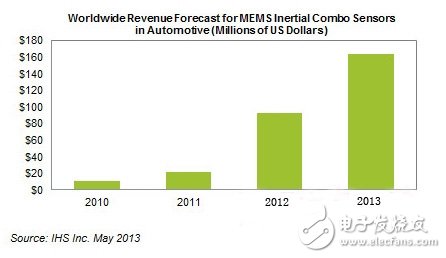Market research firm IHS iSuppli points out that thanks to the rapid popularization of automobile safety regulations and automobile safety system applications in recent years, the market for composite MEMS inertial sensors for automotive applications is expected to reach US$163 million in 2013, a significant increase of 77%.
IHS said that as more cars are equipped with safety systems, the use of these types of sensors in cars is increasing rapidly. Last year, the market for these sensors grew by about 338% to $92 million, up from $10 million in 2011.
A composite inertial sensor is a multi-sensor element that integrates an accelerometer and a gyroscope in a single package. It provides inertial input for the electronic stability control system (ESC) in the car to avoid or reduce the occurrence of skidding.
"In North America, Europe and other places with mature regulations, such as Australia, Japan, Canada and South Korea, cars are required to use ESC systems," said Richard Dixon, principal analyst for MEMS and sensors at IHS. However, "there are still huge business opportunities in some untapped areas, such as China, which provides a larger market, which will obviously affect the global penetration of ESC. However, from another perspective, it will also bring huge growth drivers and momentum to the overall automotive composite sensors."

Global composite MEMS sensor market revenue forecast (in millions of US dollars)
IHS said that the main suppliers of composite inertial sensors for automobiles include Germany's Bosch and Japan's Murata (formerly VTI); there are two other potential manufacturers, Japan's Panasonic and Massachusetts-based Analog Devices (ADI), which still need to develop similar solutions to successfully seize this market opportunity.
There are three types of ESC systems currently used in cars: The first is placed on a circuit board like a standalone ESC engine control unit (ECU). The second is connected to the brake modulator to save wiring. The third type of ESC system is co-configured with the car's airbag ECU.
Among these three different configurations, the current trend is to place the ESC system in the airbag ECU to achieve a smaller footprint and higher efficiency, especially since the space for the ECU in the car is very limited, so it is more advantageous to use a space-saving architecture.
Compared to standalone sensor configurations, sensors made specifically for combined sensor ESC system architectures, such as those developed by Continental, can save up to five times the space, IHS stressed. Non-combined solutions also exist in the form of separate mounting on the circuit board. IHS said that deploying sensors in a combined manner not only reduces packaging costs, but also minimizes the use of expensive semiconductor components because two sensors in a combined package can share the same ASIC.
One of the most important issues with ESC systems is cost, IHS explained, because ESC used to be considered an optional feature in cars; however, since the government mandated the use of ESC systems, it has now become a must-have in cars like seat belts.
Therefore, in the entire supply chain and pricing structure, automotive composite sensors have experienced tremendous pressure from automakers to downstream. Tier-1 manufacturers have passed this pressure on to suppliers, requiring them to accelerate the provision of efficient composite sensor solutions for inertial sensors in ESC systems.
IHS stressed that under this pressure, some first-tier companies believe that only traditional businesses will adopt the traditional configuration solution of PCB with independent sensors in the future. Therefore, all new car models in the future will use the composite sensor solution.
Previous article:Smart security analysis: The rise of embedded surveillance design solutions
Next article:Apple wins patent for smart security system to strengthen communications network security
- Popular Resources
- Popular amplifiers
- High signal-to-noise ratio MEMS microphone drives artificial intelligence interaction
- Advantages of using a differential-to-single-ended RF amplifier in a transmit signal chain design
- ON Semiconductor CEO Appears at Munich Electronica Show and Launches Treo Platform
- ON Semiconductor Launches Industry-Leading Analog and Mixed-Signal Platform
- Analog Devices ADAQ7767-1 μModule DAQ Solution for Rapid Development of Precision Data Acquisition Systems Now Available at Mouser
- Domestic high-precision, high-speed ADC chips are on the rise
- Microcontrollers that combine Hi-Fi, intelligence and USB multi-channel features – ushering in a new era of digital audio
- Using capacitive PGA, Naxin Micro launches high-precision multi-channel 24/16-bit Δ-Σ ADC
- Fully Differential Amplifier Provides High Voltage, Low Noise Signals for Precision Data Acquisition Signal Chain
- LED chemical incompatibility test to see which chemicals LEDs can be used with
- Application of ARM9 hardware coprocessor on WinCE embedded motherboard
- What are the key points for selecting rotor flowmeter?
- LM317 high power charger circuit
- A brief analysis of Embest's application and development of embedded medical devices
- Single-phase RC protection circuit
- stm32 PVD programmable voltage monitor
- Introduction and measurement of edge trigger and level trigger of 51 single chip microcomputer
- Improved design of Linux system software shell protection technology
- What to do if the ABB robot protection device stops
- Allegro MicroSystems Introduces Advanced Magnetic and Inductive Position Sensing Solutions at Electronica 2024
- Car key in the left hand, liveness detection radar in the right hand, UWB is imperative for cars!
- After a decade of rapid development, domestic CIS has entered the market
- Aegis Dagger Battery + Thor EM-i Super Hybrid, Geely New Energy has thrown out two "king bombs"
- A brief discussion on functional safety - fault, error, and failure
- In the smart car 2.0 cycle, these core industry chains are facing major opportunities!
- The United States and Japan are developing new batteries. CATL faces challenges? How should China's new energy battery industry respond?
- Murata launches high-precision 6-axis inertial sensor for automobiles
- Ford patents pre-charge alarm to help save costs and respond to emergencies
- New real-time microcontroller system from Texas Instruments enables smarter processing in automotive and industrial applications

 HA1-2544/883
HA1-2544/883















 京公网安备 11010802033920号
京公网安备 11010802033920号